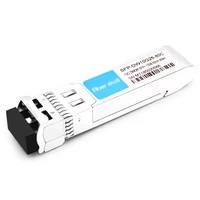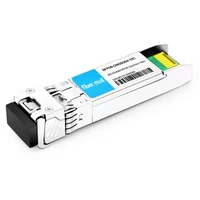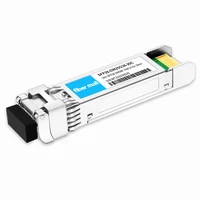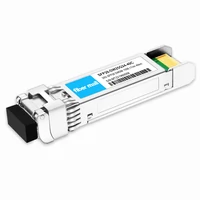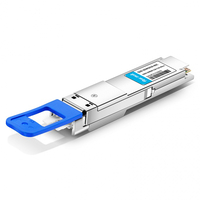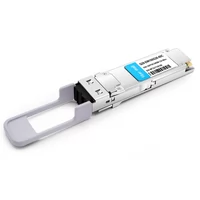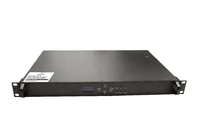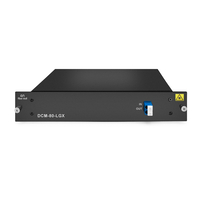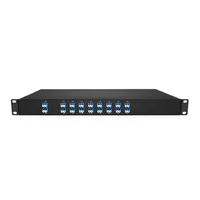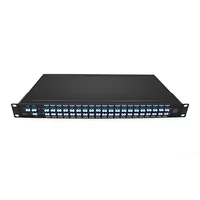Table of Contents
ToggleBasics Introduction of DWDM
Wavelength Division Multiplexing WDM is a technology that multiplexes optical signals of different wavelengths into a single fiber for transmission.

- CWDM (Coarse Wavelength Division Multiplexing) uses wide wavelength spacing, usually 20nm apart.
- DWDM (Dense Wavelength Division Multiplexing) uses narrow wavelength spacing, typically between 0.8-2nm.
Now, we will focus on introducing the Dense Wavelength Division Multiplexing (DWDM) technology in WDM.
DWDM combines optical carriers on a single fiber for transmission, increasing the transmission capacity of each fiber. DWDM can carry SDH services, IP services, and ATM services.
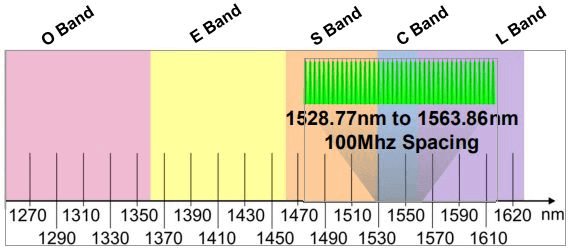
The ITU International Telecommunication Union standard for DWDM wavelengths is 1528.77nm-1563.86nm, mainly in the C-band with low attenuation and dispersion. 100GHz (0.8nm) wavelength spacing can have 40 channels, 50GHz (0.4nm) wavelength spacing can have 80 channels.
The Structure of the DWDM Unit
Dense Wavelength Division Multiplexing (DWDM) is a relatively advanced optical fiber communication technology at present. With the development of the economy and technology, people’s demand for data transmission speed has also increased to a relatively high level, resulting in a bright prospect of DWDM technology.
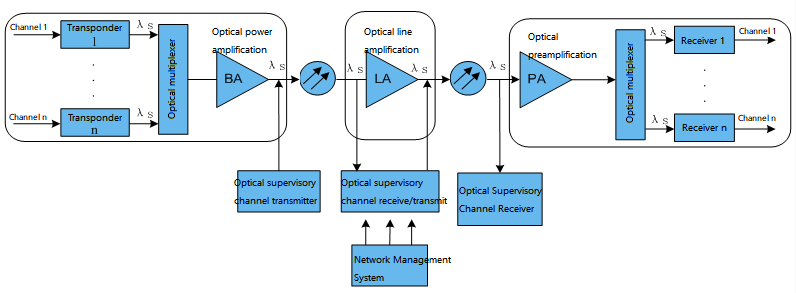
- Optical transponder: Converts wavelength light signals;
- Optical multiplexer and splitter: Combines and splits fixed wavelength light signals;
- Optical amplifier (OLA): located in the middle of the optical transmission section, the OLA amplifies the optical signal;
- Optical supervisory channel: used to carry the management and monitoring of DWDM system, so that the network management system can effectively manage the DWDM system.
The Working principle of the DWDM system
Dual-fiber unidirectional transmission
A unidirectional WDM system uses two optical fibers. One fiber only completes the transmission of optical signals in one direction, and the transmission of reverse optical signals is completed by the other fiber.
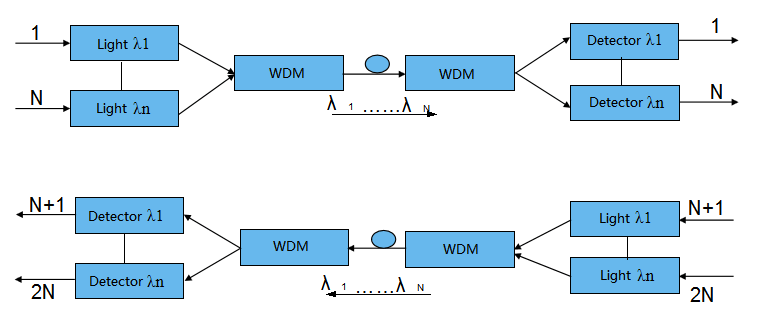
Advantages: Each signal is carried by a different wavelength, ensuring that there is no interference, and the same wavelength can be reused in both directions.
Disadvantages: Low utilization of fiber and optical device resources.
Single-fiber bidirectional transmission
A bi-directional wavelength division multiplexing (WDM) system uses a single fiber to transmit signals in both directions, with different wavelengths carrying the signals in each direction, achieving full-duplex communication.
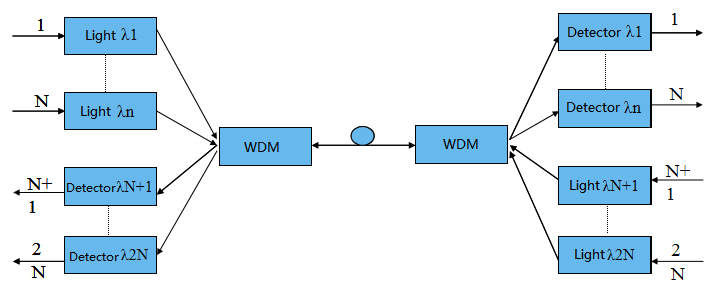
Advantages: can reduce the number of fibers and line amplifiers used, saving costs.
Disadvantages: high requirements, need to solve the multi-channel interference, extended transmission distance requires optical amplification.
Classification of DWDM Systems
Open DWDM system

In the transmission end, OTU is used to convert non-standard wavelengths into standard wavelengths. The main function of this device is to convert non-standard wavelengths into standard wavelengths specified by ITU-T to meet the wavelength compatibility of the system.
Integrated DWDM system

The service signal itself already meets the standard wavelength, and no OTU is needed at the transceiver and transmitter.
Key Components of DWDM
Light source:
The function of the light source is to generate laser or fluorescence, which is an important device in fiber optic communication systems.
The light source of DWDM system has a relatively large dispersion tolerance and standard and stable wavelength.
There are two modulation methods for lasers: direct modulation and indirect modulation.
Photodetector:
The role of the photodetector is to convert the received optical signal into a corresponding electrical signal.
As the optical signal transmitted over the fiber is generally very weak, high requirements are placed on the photodetector.
Optical amplifier:
The optical amplifier is used to enhance the optical signal and mainly includes Erbium Doped Fiber Amplifier (EDFA) and Raman fiber amplifier.

Optical multiplexer and optical demultiplexer:
The core components of WDM system are wavelength division multiplexer, i.e. optical multiplexer and optical demultiplexer, which are actually optical filters. Their characteristics largely determine the performance of the whole system, and the requirements are sufficient number of multiplexing channels, small insertion loss, wide passband range, etc.

There are many types of optical wavelength division multiplexers, which can be roughly divided into four categories: interference filter type, fiber coupler type, grating type, and array waveguide grating type.

Types of network
Point-to-point Network

Mesh Network

Ring Network
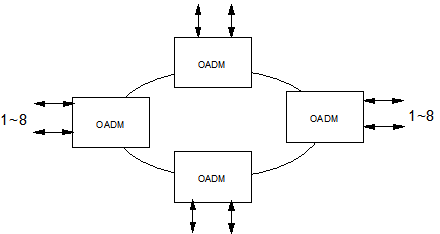
Advantages of DWDM Technology
- Ultra-large capacity: Because DWDM technology makes full use of fiber bandwidth resources, multiplexing dozens or even hundreds of channels in a single fiber, the capacity of a single fiber is greatly improved.
- “Transparent” transmission of data: The DWDM system is transparent to “data” and is independent of signal rate and electrical modulation method. Therefore, multiple business signals with completely different rates, formats, and characteristics can be transmitted simultaneously.
- Convenient and flexible system upgrade and expansion: New services can be introduced by adding wavelengths without interrupting existing services, maximizing the protection of existing investments.
- Economical and reliable networking: The new communication network constructed using DWDM technology is much simpler than the network composed of traditional electrical time-division multiplexing technology, and the network hierarchy is clear. Due to the simplified network structure, clear hierarchy, and convenient business scheduling, the economy and reliability of the network are obvious.
- Form an all-optical network: DWDM technology will be one of the key technologies for achieving an all-optical network, and DWDM systems can be compatible with future all-optical networks. In the future, it may be possible to achieve a transparent and highly survivable all-optical network based on the already-built DWDM network.
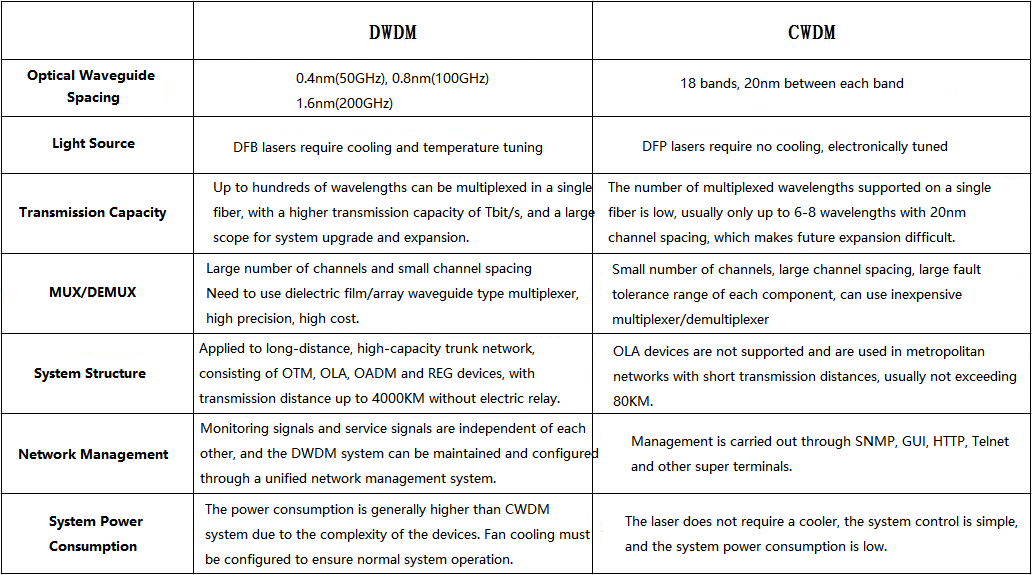
DWDM and CWDM technology are two different products of wavelength division multiplexing technology, and each has advantages in different network layers.
Due to its low cost and simple structure, CWDM technology has good application prospects in the access layer of metropolitan area networks with its multi-service features. DWDM technology, on the other hand, is preferred for backbone networks, core metropolitan area networks, and local network backbone transmission equipment due to its high capacity and long-distance transmission characteristics.
When choosing CWDM/DWDM solution, the best solution should be selected by considering the project requirements and budget and also combining their characteristics and differences.
Discussion on DWDM Technology
DWDM belongs to the wavelength-division multiplexing (WDM) technology, which is a mature technology that has been widely used in the field of optical fiber communication transmission. WDM utilizes the transmission characteristics of light waves to press together light waves of different wavelengths and frequencies through an optical multiplexing system so that data can be transmitted through a single optical fiber. The schematic diagram of its system structure is shown in figure.
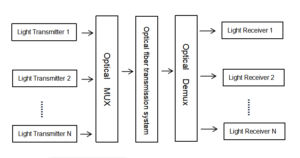
Propagation diagram of the WDM technology
The optical wave multiplexer and the optical wave demultiplexer are the core of the entire WDM system. At present, the two functions of wave multiplexer and demultiplexing can be integrated into one machine, which is regarded as an optical multiplexing system, similar to the modem that can perform both modulation and demodulation functions in the early copper transmission system. With the development of science and technology, the sensitivity of the optical multiplexing system-related machines has been improved, and it has been able to perform multiplexing and demultiplexing operations on optical signals with very similar wavelengths and frequencies, which lays a solid foundation for the wide application of DWDM technology.
Channel Center Frequency(THz) Wavelength(nm) Channel Center Frequency(THz) Wavelength(nm) Channel Center Frequency(THz) Wavelength(nm) Channel Center Frequency(THz) Wavelength(nm)
C21 192.1 1560.61 C31 193.1 1552.52 C41 194.1 1544.53 C51 195.1 1536.61
C22 192.2 1559.79 C32 193.2 1551.72 C42 194.2 1543.73 C52 195.2 1535.82
C23 192.3 1558.98 C33 193.3 1550.92 C43 194.3 1542.94 C53 195.3 1535.04
C24 192.4 1558.17 C34 193.4 1550.12 C44 194.4 1542.14 C54 195.4 1534.25
C25 192.5 1557.36 C35 193.5 1549.32 C45 194.5 1541.35 C55 195.5 1533.47
C26 192.6 1556.55 C36 193.6 1548.51 C46 194.6 1540.56 C56 195.6 1532.68
C27 192.7 1555.75 C37 193.7 1547.72 C47 194.7 1539.77 C57 195.7 1531.9
C28 192.8 1554.94 C38 193.8 1546.92 C48 194.8 1538.98 C58 195.8 1531.12
C29 192.9 1554.13 C39 193.9 1546.12 C49 194.9 1538.19 C59 195.9 1530.33
C30 193 1553.33 C40 194 1545.32 C50 195 1537.4 C60 196 1529.56
DWDM wavelength: wavelength allocation of 40-wave DWDM 100G
In a DWDM system, a single optical cable can transmit multiple light waves of different wavelengths and frequencies, and these light waves propagate along different optical channels divided in the optical fiber, which makes the speed of the data that was originally 2.5GB/s in an optical cable be increased many times. At present, the maximum data traffic that can be transmitted by a single fiber has reached 400Gb/s. The DWDM system has incomparable advantages in the application.
First, multiple optical signals are combined on one channel for transmission, which effectively improves the transmission efficiency of data. Secondly, this technology can effectively reduce costs, especially in the long-distance data transmission process using optical fibers as transmission carriers. Optical multiplexing technology, especially DWDM technology, can greatly save optical fibers and optical signal regeneration equipment, and at the same time the EDFA technology, external modulation, electro-absorption, and other technologies involved in transmission make the allowable loss and dispersion of the hops of the entire transmission system larger, effectively extending the transmission distance.
At the same time, the DWDM system is equivalent to virtualizing multiple optical fiber channels in one optical fiber, so it has good compatibility for the transmission of various data, effectively improving the survivability of the entire optical fiber transmission system, and is also very convenient for expansion operations.
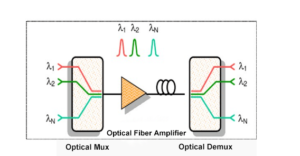
theoretical system diagram of the DWDM technology
Network Analysis of DWDM
Optical fiber’s own characteristics determine that it is difficult to correct after the laying of the optical fiber network is completed. The DWDM network involves various technologies, so it should be treated with more caution in the design process.
The overall structure of the DWDM system with N wavelength multiplexing mainly includes the following:
- Optical transponder unit (OTU);
- Wavelength division multiplexer: Optical demultiplexer/multiplexer (ODU/OMU);
- Optical amplifier (BA/LA/PA);

The overall structure of the DWDM system with N wavelength multiplexing
The classification of DWDM networks is complicated with various classification criteria, including the way of carrying services, whether wavelength can be converted, whether there is photoelectric conversion in the transmission process, etc. The topological structure of the network must be considered during its construction and design.
Like the traditional data transmission network, the DWDM network is also divided into the mesh, ring, star, and bus networks in topological structure. In the current application environment, mesh and ring networking methods are more common. When determining the networking mode, the main factors that need to be considered include cost and network performance. Specifically, it should include the maximum point-to-point data volume that the network can transmit, network routing capabilities, network security, network autonomous resilience, etc.
On the basis of the overall consideration of the above problems, the final form and related parameters of the network are determined according to the characteristics of different topological structures. It is generally recommended to adopt a unified design scheme to avoid splitting the entire design process into several stages, which can effectively maintain the consistency of the entire website planning and improve the comprehensive communication capability of the network.
Taking the mesh fiber network as an example, designers need to pay special attention to the environmental needs and take into account the changes in the entire demand environment in the future development process, and then estimate the corresponding parameters according to the needs, including the size of the OXC located at different nodes, the number of fibers, and the wavelength requirements among nodes. Due to the weak self-healing ability of the mesh topology, the problems that need to be determined in the design process are basically concentrated on the capacity of the network, especially when the associated road or node in the network fails, the transfer bearer problem related to data requirements is the main point to consider.
In contrast, the self-healing capability of the ring network is slightly better, so more attention is paid to the design of the network level. Special attention should also be paid to the problem of segmenting and locating the ring network structure and function based on intra-ring routing and wavelength allocation. Different from the mesh fiber network, the ring network does not need to consider the allocation of idle network capacity, because the idle capacity itself is embedded in the ring network. After the network design process, optimization issues must also be considered for DWDM networks. This needs to optimize the configuration of each link according to the actual parameters in the network, and the process has been carried out until the entire network is laid.
In an environment with a transmission rate of more than 10Gb/s, problems such as signal distortion have a great impact on the quality of transmission, so the optimization of the network is crucial. In this process, the work includes the determination of the basic configuration during project bidding, the measurement of actual parameters during project execution, the adjustment of the DCM module and pump card, and the actual parameter settings of each specific segment according to the measurement results, and the adjustment of signal pre-emphasis, and many other aspects. Only by carefully implementing each link can we obtain high-quality signal transmission services.
DWDM Optical Module Realizes Low-Cost Expansion of Fiber Capacity
In traditional transmission modes, a single fiber can only transmit optical carrier signals carrying one type of information.
Ordinary dual-fiber optical module (transmitting over 2-core fibers).

It can be replaced with a BIDI optical module (transmitting over a single-core fiber) when additional services are needed but fiber resources are limited.

When the number of services continues to increase and BIDI is no longer sufficient, a WDM optical module (mainly DWDM) can be used, which is what we are introducing here—DWDM SFP optical module and DWDM SFP+ optical module.
About Wavelength Division Multiplexing (DWDM)
DWDM wavelength division multiplexing is a WDM, which is the multiplexing of optical signals of different wavelengths into one fiber for transmission.
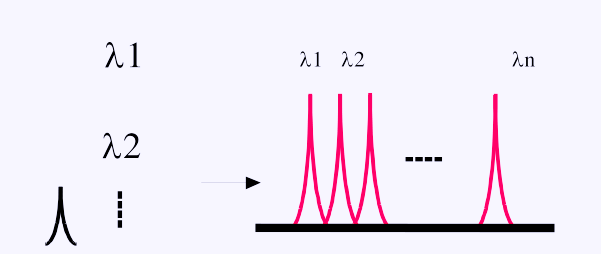
In the traditional transmission mode, one fiber can only carry one kind of information optical carrier signal. In the case of different services, different fibers are required for transmission. DWDM wavelength division multiplexing technology can provide multiple virtual fiber channels on a single physical fiber.

DWDM channels are more densely spaced and use C-band (1525nm-1565nm) and L-band (1570nm-1610nm) transmission windows, which are small segments taken out from inside the CWDM wavelength range. DWDM channel spacing is 0.4nm, 0.8nm, 1.6nm, etc. (CWDM band spacing is 20nm), which is smaller and requires additional wavelength control devices.
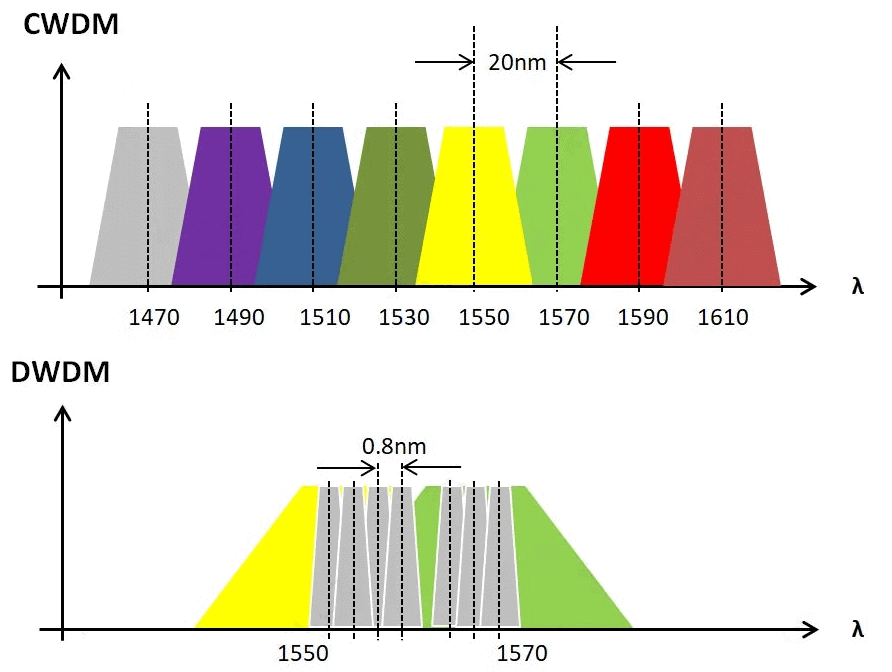
DWDM Optical Transceiver Module
DWDM optical modules, also known as colored light optical modules, are an important component in optical modules for converting optoelectronic signals. Similar to ordinary optical modules, DWDM optical modules need to be used with DWDM wavelength division multiplexers to multiplex optical signals of different wavelengths onto a single fiber for transmission. At the receiving end of the link, the mixed signal in the fiber is demultiplexed into different wavelength signals by an optical demultiplexer to achieve long-distance communication transmission.
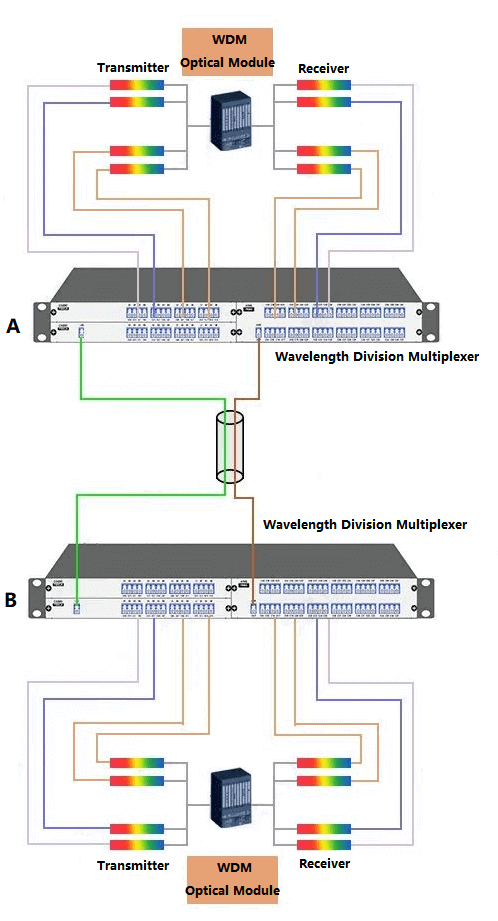
Common package types for DWDM optical modules include SFP, SFP +, XFP, SFP28, QSFP +, and QSFP28, which have the advantages of high transmission capacity, small size, low power consumption, LC duplex interface, DDM (digital diagnostic function), etc.
Common DWDM optical modules include 1.25G SFP DWDM, 10G SFP+ DWDM, 10G XFP CWDM, 25G SFP28 DWDM, 40G QSFP+ DWDM, and 100G QSFP28 DWDM. The common transmission distance of DWDM optical modules is 40km, and options for 80km and 120km are also available (multiple relay stations can be used to extend the transmission distance beyond 120km).
Two Application Solutions for DWDM Optical Transceiver Modules
Dual-fiber unidirectional DWDM transmission solution
Dual-fiber unidirectional refers to the simultaneous transmission of all optical paths in the same direction on a single fiber. Different wavelengths carry different optical signals, which are multiplexed at the transmitting end and transmitted through a single fiber. At the receiving end, they are demultiplexed to complete the transmission of multiple optical signals, while the opposite direction is transmitted through another fiber. The two directions of transmission are completed by two separate fibers.
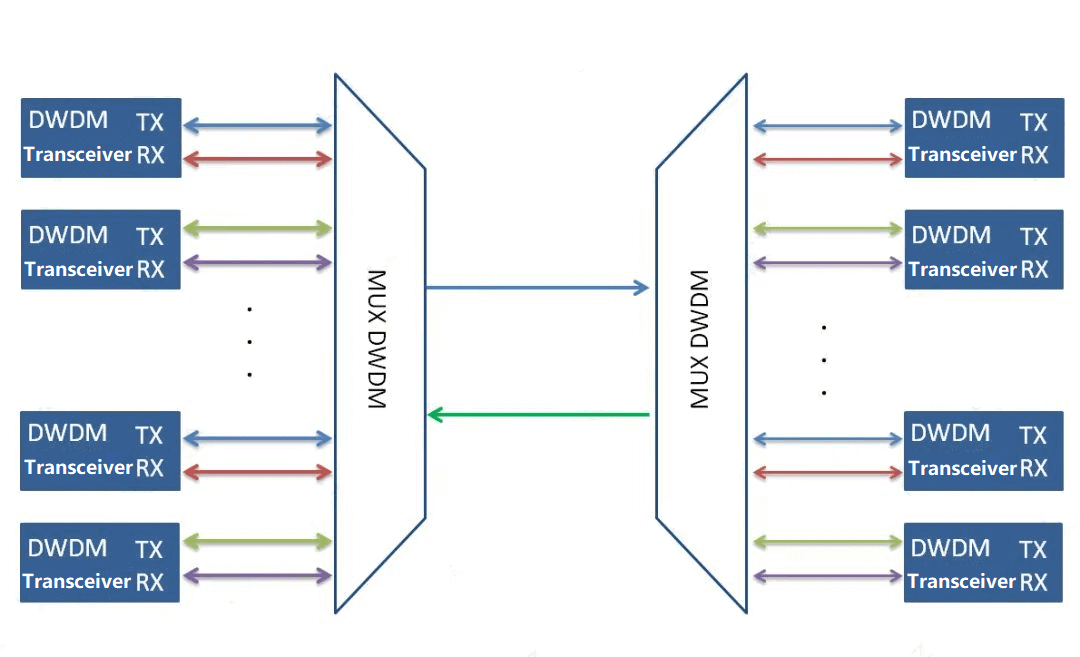
Single-fiber bidirectional DWDM transmission solution
Single-fiber bidirectional means that the optical signal adopts different wavelengths for sending and receiving on a single fiber to achieve bidirectional transmission of services.
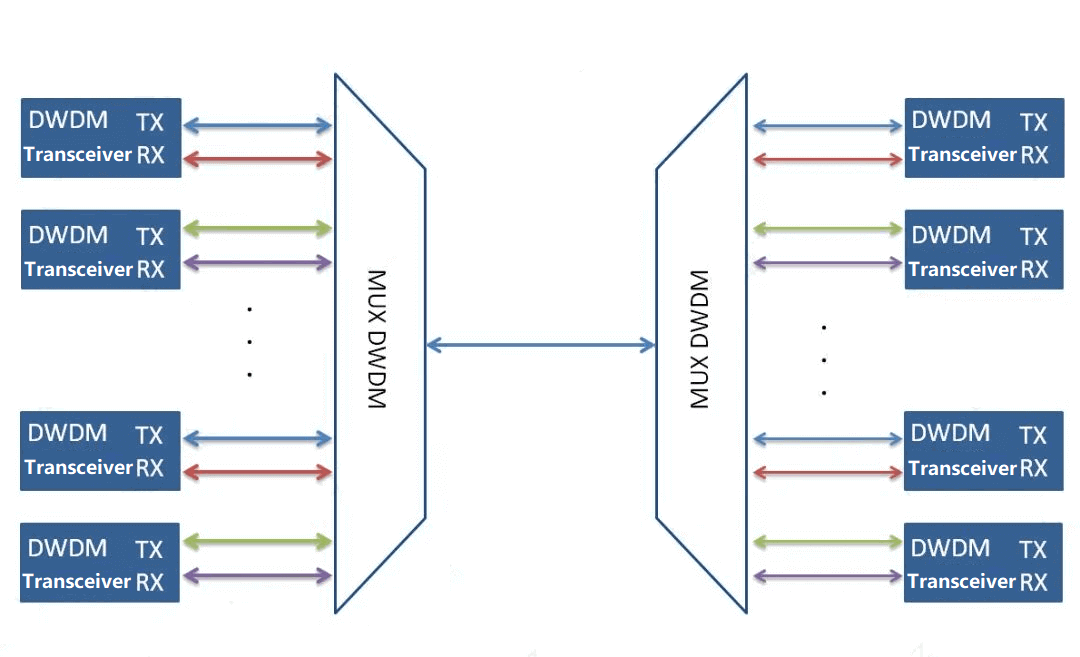
Related Products:
-
 Cisco DWDM-SFP10G-56.55 Compatible 10G DWDM SFP+ C26 100GHz 1556.55nm 80km LC SMF DDM Transceiver Module
$175.00
Cisco DWDM-SFP10G-56.55 Compatible 10G DWDM SFP+ C26 100GHz 1556.55nm 80km LC SMF DDM Transceiver Module
$175.00
-
 Cisco DWDM-SFP25G-34.25 Compatible 25G DWDM SFP28 C54 100GHz 1534.25nm 10km LC SMF DDM Transceiver Module
$265.00
Cisco DWDM-SFP25G-34.25 Compatible 25G DWDM SFP28 C54 100GHz 1534.25nm 10km LC SMF DDM Transceiver Module
$265.00
-
 SFP28-DW25G36-20C 25G SFP28 DWDM C36 100GHz 20KM 1548.51nm LC SMF DDM Transceiver Module
$600.00
SFP28-DW25G36-20C 25G SFP28 DWDM C36 100GHz 20KM 1548.51nm LC SMF DDM Transceiver Module
$600.00
-
 SFP28-DW25G24-40C 25G SFP28 DWDM C24 100GHz ER 40KM 1558.17nm LC SMF DDM Transceiver Module
$750.00
SFP28-DW25G24-40C 25G SFP28 DWDM C24 100GHz ER 40KM 1558.17nm LC SMF DDM Transceiver Module
$750.00
-
 Cisco Compatible 100G DWDM QSFP28 C29 C30 100GHz CS DDM Optical Transceiver
$1600.00
Cisco Compatible 100G DWDM QSFP28 C29 C30 100GHz CS DDM Optical Transceiver
$1600.00
-
 Q28-DW100G26-80C Compatible 100G DWDM QSFP28 PAM4 Single Wave C26 1556.55nm 100GHz LC 80km DDM Optical Transceiver Module
$1900.00
Q28-DW100G26-80C Compatible 100G DWDM QSFP28 PAM4 Single Wave C26 1556.55nm 100GHz LC 80km DDM Optical Transceiver Module
$1900.00
-
 EDFA 40/80 Channels DWDM C-Band Optical Pre-Amplifier Maximal Output Power +16dBm Gain 25dB Saturated Optical Power -9dBm
$1139.00
EDFA 40/80 Channels DWDM C-Band Optical Pre-Amplifier Maximal Output Power +16dBm Gain 25dB Saturated Optical Power -9dBm
$1139.00
-
 DCM 80km DCF-based Passive Dispersion Compensation Module, 8.0dB Low Loss, LC/UPC Connector
$929.00
DCM 80km DCF-based Passive Dispersion Compensation Module, 8.0dB Low Loss, LC/UPC Connector
$929.00
-
 DWDM MUX DEMUX 16CH (C21-C36) with Monitor Port LC/UPC Dual Fiber 1U Rack
$800.00
DWDM MUX DEMUX 16CH (C21-C36) with Monitor Port LC/UPC Dual Fiber 1U Rack
$800.00
-
 DWDM MUX DEMUX 40CH (C21-C60) LC/UPC Dual Fiber 1U Rack
$1100.00
DWDM MUX DEMUX 40CH (C21-C60) LC/UPC Dual Fiber 1U Rack
$1100.00

